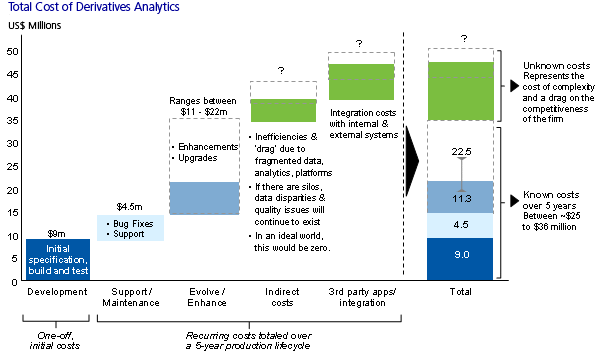Optimizing the OTC Pricing and Valuation Infrastructure
Abstract
Celent urges firms to re-examine and explore better approaches in managing costs associated with derivatives analytics, as study uncovers significant duplication of analytics across front, middle, and back offices. Findings suggest that firms adopting in-house strategies for OTC pricing will require significant investments between $25 million and $36 million alone to build, maintain, and enhance a complete derivatives library over a five-year lifecycle.
The bespoke nature of OTC derivatives and structured deals makes pricing and risk evaluation an extraordinary challenge. Traditionally, due to prohibitive costs and the limited number of options available, most banks, asset managers, and hedge funds overcome this obstacle through a dependence on broker-dealers to furnish prices for instruments with more complex payout structures. In recent years, however, the industry has seen banks and investment firms build up their own pricing and valuation capabilities to counter this overreliance.
“Despite advances in analytic tools and integration technologies, the deployment of sound pricing and risk capabilities remains an uphill battle, due to limitations of legacy in-house IT environments, access to suitable quantitative expertise, internal cost pressures, and ongoing regulatory, accounting, and investor demands,” says Cubillas Ding, Research Director at Celent and author of the report. “The bar is continually being raised to address not merely valuation risks, but also broader systemic and operating risks associated with OTC derivatives operations.”
With the deterioration of many high-margin businesses, profound structural changes in OTC markets, and a shift towards flow activities, Celent expects firms to face greater pressures to rationalize operational and IT overheads should these scenarios manifest themselves. At the same time, with increased overheads and downstream “parallel requirements” for risk controlling activities such as independent price verification, model validation, and independent valuations, even larger firms increasingly struggle to manage the provision of pricing and risk analytics.
In a joint study with FINCAD, Celent’s analysis suggests that firms pursuing in-house efforts for derivatives analytics require an upfront investment of at least $9 million. Moreover, depending on the “aggressiveness” of an institution, recurring annual costs can range between 25% and 50% of initial investment to keep pricing and risk analytics relevant. This translates to $11 million to $22 million over a five-year production lifecycle to enhance and keep libraries current with ongoing market requirements across multiple asset classes. While the majority of firms do not reach the higher extreme of that range, the level of expenditure does vary significantly by firm—dictated by the nature of a firm’s investment strategy, and how dynamic price models need to be. Aggregated over the total software lifecycle, firms adopting in-house strategies for OTC pricing will require investments between $25 million and $36 million alone to build, maintain, and enhance a complete derivatives library.

“Firms can gain cost efficiencies by leveraging commercial tools for standard functionality, focusing internal development on activities that provide higher margins or business differentiation,” says Robert Park, CEO and President of FINCAD. “We find a growing acceptance of embedding third party solutions because they see that buying the analytics will reduce costs, accelerate time to market, and increase overall efficiency.”
In buoyant markets, firms have historically pursued organic approaches for derivatives analytics. Looking ahead, as one-off rebound revenues drop away and margins tighten, this will reinforce the need for financial firms to compete for share and improve trading efficiency. Tighter margins mean that achieving scale in core flow OTC products is critical. At the same time, there is a need to be mindful of cost efficiencies. The report also recommends ways of optimizing OTC pricing and valuation setups in order to increase operational efficiency.
About Celent
Celent is a research and advisory firm dedicated to helping financial institutions formulate comprehensive business and technology strategies. Celent publishes reports identifying trends and best practices in financial services technology and conducts consulting engagements for financial institutions looking to use technology to enhance existing business processes or launch new business strategies. With a team of internationally experienced analysts, Celent is uniquely positioned to offer strategic advice and market insights on a global basis. Celent is a member of the Oliver Wyman Group, which is part of Marsh & McLennan Companies [NYSE: MMC].
For more information, visit www.celent.com.
About FINCAD
Founded in 1990, FINCAD provides software and services supporting the valuation and risk management of cross-asset class derivatives and fixed income securities to banks, corporate treasuries, asset management firms, auditors, and governments. FINCAD is the industry standard for financial analytics used by more than 35,000 financial professionals in over 80 countries. Over 70 FINCAD Alliance Partners embed FINCAD analytics within their solutions.
For more information visit www.fincad.com.

